Kathleen Flinn's Blog, page 10
November 3, 2020
19 Ideas for Thanksgiving Leftovers
 Kentucky Hot Browns: a masterful use of holiday leftovers
Kentucky Hot Browns: a masterful use of holiday leftoversPersonally, I think leftovers are the best part of any holiday dinner. When I go shopping for the main meal, I think ahead to what I’ll do with the leftovers. Will ham be on the table? I’ll pick up split peas or beans. Turkey? I plan on making soup or gumbo with stock made from the bones.
A few years ago, I quizzed food writer friends about what they did with their holiday leftoves. Here’s some advice from them, along with some fresh ideas.
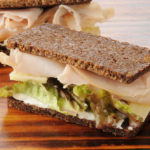 1. Update the traditional leftover sandwich
1. Update the traditional leftover sandwich“I just recently created some holiday recipes for a grocery store and some of them used leftover turkey,” Amy says. “One of my absolute favorite recipes was a turkey, jack cheese and cranberry sauce melt on whole wheat bread.” A great example: her grilled cheese, pear and turkey sandwich.
“Turkey is really good in all kinds of grilled cheese sandwiches, so get as creative as you like with it,” Sherman says. ” Try it with chutney, slices of apple, tomato, roasted red pepper or a layer of leftover cooked vegetables like sautéed spinach or creamed onions. You could even use turkey in a Reuben (in place of pastrami) or Cuban sandwich (in place of the roast pork). I like cheddar, jack or swiss cheese paired with turkey. Grilled cheese turkey sandwiches are so easy to make even kids can make them. Best of all they let you enjoy some of the flavors of Thanksgiving in a fresh way.”
 2. Make a Drink with the Cranberry Sauce
2. Make a Drink with the Cranberry SauceSeriously. For an elegant post-holiday toast, make a simple cranberry champagne cocktail by putting a teaspoon into the bottom of a flute and top with sparkling wine. Alternately, you can try my recipe for a “Crantini” for a post-shopping break. Combine 1 1/2 oz. gin, 1/2 oz. Cointreau, 1 teaspoon cranberry sauce in a shaker with ice. Shake vigorously and pour into chilled martini glass. Garnish with lime wedge.
3. Mashed potato patties
Olga Massov has a terrific idea for leftover veggies. “One of my favorite things to do is to take leftover mashed potatoes and make these mashed potato patties with them and whatever leftover vegetables I have. Usually it’s caramelized onions and/or squash so I just combine them (cut the squash into smaller pieces if need be), bind with an egg, and fry in olive oil. I mix a lemon-dill yogurt dipping sauce and voila – vegetables reborn. It makes for a really delicious post Thanksgiving lunch!”
4. Kentucky Hot Browns
My brother’s family has lived in Louisville for more than a decade. When my niece was married at the famed Brown Hotel, the meal options for the reception included a Kentucky Hot Brown. Looking around the room, it appeared 95% of the guests were tucking into one. A Hot Brown is basically an option faced sandwich topped with turkey, thin slices of tomato and a creamy cheese sauce. This is broiled until it’s slightly browned and bubbly and then topped with slices of bacon. I often skip the bacon and top the tomato with diced ham (if it was part of the meal) and then broil it. In place of the tomato, I’ve used leftover green beans or Brussel sprouts with great results. Try the original recipe from The Brown Hotel.
 5. Make Stock
5. Make Stock“I always make stock,” says Sheri Wetherall, the editor-in-chief of Foodista.com. “I roast the carcass with carrots, onions, celery and whatever yummy root veggies I have on hand until the bones are dark and golden, then simmer it for a long time on as low as I can get it until I have a luscious broth! I freeze it in small-sized batches for soups throughout the year. Check out my latest take on bone broth/stock for tips on how to extract the most goodness from those bones.
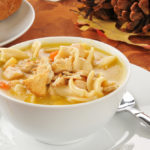 6. Make Soup
6. Make SoupWhen you’ve got the stock, you can make a wide range of soups. You can keep the flavor of the holiday meal or really change it up. Check out my Soup 101 guide for how to make soup out of virtually anything. Meanwhile, here a couple of my favorite options from food writer friends:
Comforting Turkey Potato Soup from the WhiteOnRiceCouple.com
Turkey Soup with Lemon and Barley from SimplyRecipes.com
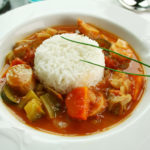 7. Turkey Gumbo
7. Turkey GumboJaden Hair of Steamy Kitchen is a fan what I typically do with a leftover turkey: make turkey gumbo. “What’s great about this is that it’s nearly a one-pot meal, easy to make and has such intense flavor that’s DIFFERENT from night-before Thanksgiving menu,” Jaden says. I totally agree. See my guide on how to make gumbo out of (almost) anything.
8. Turkey and Dumplings
Keep the comfort food going. Wetherall has a great twist on the classic chicken and dumplings on Foodista.com.
9. Make Turkey Salad
A twist on chicken salad, a simple turkey salad can be an easy lunch when plopped onto a bed of simple greens or put inside a pita. I like this recipe from Kalyn’s Kitchen.
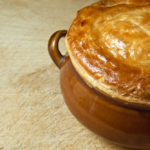 10. Turkey Pot Pie
10. Turkey Pot PieA classic. I liked this updated version with cheddar biscuits as the top crust from Just a Taste.
11. Sweet Potato Souffle
If you end up with a lot of mashed sweet potatoes like we seem to every year, consider trying your hand at shifting them into a souffle. Note: this won’t work if you covered up their naturally sweet flavor with tons of syrup or marshmallows. Marla Meredith at FamilyFreshCooking.com has a lovely recipe for sweet potato souffles with feta and sage.
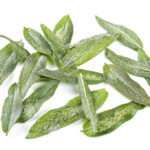 12. Fry the Leftover Sage Leaves
12. Fry the Leftover Sage LeavesI did this a couple of years ago. It genuinely intensifies the flavor and adds a certain something to a leftover sandwich or even crumbled into a dish. Saveur’s recipe is the best one I’ve found.
 13. Try Turkey Curry
13. Try Turkey CurryRemember the opening of Bridget Jones Diary? Every New Year’s Day, Bridget’s mother hosted her turkey curry buffet. I found it hard to get a turkey in November. Why? They don’t celebrate Thanksgiving and turkey tends to be reserved for Christmas dinner. Curry is a very traditional means to dispatch the leftovers from the holiday turkey. I’ve used this recipe from the BBC site for the past couple of years. When it calls for “double cream,” you just use whipping cream. I’ve used sweet potatoes in place of the butternut squash.
 14. Make croutons
14. Make croutonsIt seems like there’s always leftover rolls and bread from holiday meals. You can only eat so many sandwiches or consume so many carbs. Don’t throw it away. Dice it up, toast it and make it into croutons.
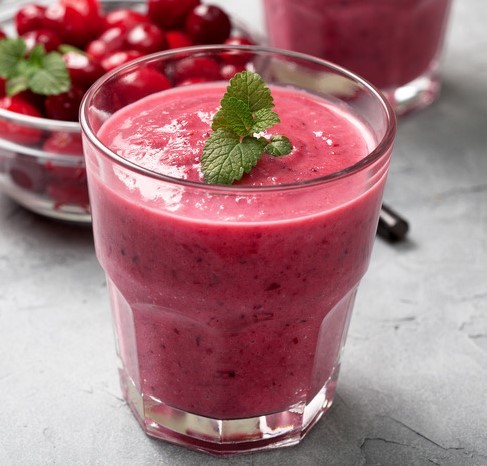
15. Orange Cranberry Smoothies
Even a couple tablespoons of cranberry sauce can transform a simple smoothie. In a blender, combine a few tablespoons of leftover cranberry sauce, ¼ cup orange juice, ½ cup yogurt, a banana, a bit of honey and blend together. Taste and add a bit more honey if needed.
16. BLT Turkey Tacos with Cranberry Salsa
I tried this recipe from How Sweet Eats a couple of years ago. I admit that I use tortillas something of a crutch to use up leftovers. This felt like a great complement to the carb heavy holiday meal with a few crumbles of bacon tossed in to complement the sweetness of the cranberry salsa.
17. Turkey Panzanella
By definition, the famed Italian summer lunch dish, panzanella, is itself a leftover dish. In this classic Tuscan dish, chunks of stale white bread are tossed with sliced onions, chopped tomatoes and basil then soaked with a vinaigrette made with good olive. Take the leftover rolls and bread from the dinner and toast lighter if not sufficiently stale, make a lemony vinaigrette and toss in chopped turkey, tomatoes and herbs.
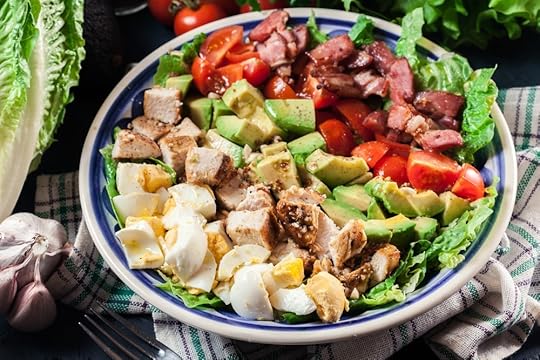 Use up leftover turkey and ham in a composed salad, such as a Cobb
Use up leftover turkey and ham in a composed salad, such as a Cobb18. Turkey Cobb Salad
If you’re ready to go low carb after the big dinner, a cobb salad is just the ticket. Grab a couple avocados, tomatoes and some bleu cheese when you’re shopping for the rest of the meal. After that, all you have to do is boil a couple of eggs. Take leftover turkey and ham (or bacon) and voila!
19. Meatballs from Leftover Stuffing
Finely chop turkey and mix leftover stuffing with an egg and leftover stuffing and Italian seasoning and bake for about 10 minutes. Put on a roll with some cheese for a lovely meatball sandwich. If you want more traditional meatballs with beef (or a plant-based ground protein), check out this recipe from Good Housekeeping.
Originally published in 2014. Updated November 2020.
The post 19 Ideas for Thanksgiving Leftovers appeared first on Kathleen Flinn.
October 31, 2020
Thanksgiving Guide Pandemic Style
Every year I polish up my Thanksgiving guide with all the usual fare, from a primer on turkeys to what to do with leftovers. Bu this is not a usual year. How do you celebrate and be thankful in the middle of a pandemic? We will see more than five people at our Thanksgiving table. Also, what if you’re just playing sick of cooking?
So I changed things up this year. I kept the usual suspects but added a few.
[Updated November 2020]
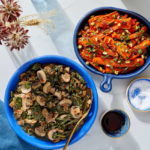 Sick of Cooking? Get Thanksgiving in a Box
Sick of Cooking? Get Thanksgiving in a BoxOrder in from a local restaurant, try a meal kit or a pre-cooked sides or the whole thing.
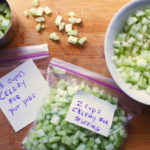 27 Holiday Dinner Tips from the Pros
27 Holiday Dinner Tips from the ProsNovice cooks wanted pros to weigh in on planning and executing a Thanksgiving meal. I asked a panel of food writers what strategies they’ve learned and pulled them together for a guide every cook can learn from.
 Frequently Asked Questions: Turkey
Frequently Asked Questions: TurkeyA one-page guide to common questions featuring brief, sensible answers. From what type of bird to buy to how to cook it and carve it. I even tackle whether you can cook a frozen turkey.
 What to Buy? What to Make?
What to Buy? What to Make?Just assembling all the stuff for a big holiday dinner can be confusing. How much to buy per person? What can you buy guilt-free?
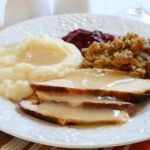 How to Put Together a Holiday Menu
How to Put Together a Holiday MenuSure, it seems obvious. But if you’ve never done it, or you feel like you’re always overdoing it, take these tips from top food writers.
 Processed vs Homemade
Processed vs HomemadeI challenged a group of firefighters to tell the difference between a holiday meal made with an organic turkey and homemade sides and another with a frozen bird and sides from boxes, cans and jars. The result? Take a look.
 14 Great Ideas for Leftovers
14 Great Ideas for LeftoversLeftovers are just as much of a holiday tradition as turkey and cranberry sauce. I’ve pulled some creative ways to make the most of them.
Foolproof Recipes
 Easy as Pie
Easy as PiePie maven Kate McDermott from Art of the Pie on the perfect pie crust, plus why no one should feel guilty using canned pumpkin.
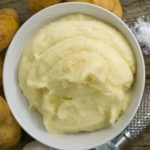 Perfect Mashed Potatoes
Perfect Mashed PotatoesFluffy, not lumpy, my Le Cordon Bleu-inspired recipe with a video by Chef John of FoodWishes.com
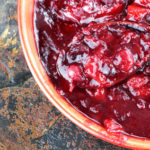 Cranberry Relish with Orange and Port
Cranberry Relish with Orange and PortIf you can open a can of cranberries, you can make my family’s recipe for this classic from scratch. Promise.
 Potato Gratin with Chevre and Pancetta
Potato Gratin with Chevre and PancettaA different take on potatoes from food writer Jess Thompson that can be made in advance and heated up just before the big dinner.
 Carrots roasted with Mustard
Carrots roasted with MustardSurprisingly simple, strikingly tasty. Another winner from Jess Thompson’s book, Cooking Up Washington
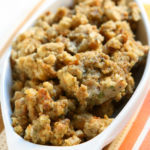 Bread Stuffing with Apples, Bacon and Caramelized Onions
Bread Stuffing with Apples, Bacon and Caramelized OnionsA simple, classic recipe from the celebrated food writer Diane Morgan. Cook the onions and bacon a day in advance, toss ingredients together and bake.
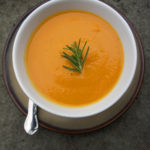 Carrot and Rosemary Soup
Carrot and Rosemary SoupAn inexpensive, easy way to put the flavor of autumn in a bowl. Another make-ahead recipe with a complex taste but simple steps.
Finishing Butter
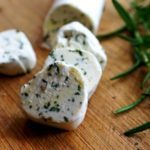 Adding a pat of flavored butter to simply prepared vegetables is perhaps the easiest side dish of them all. Learn just how easy it is to assemble.
Adding a pat of flavored butter to simply prepared vegetables is perhaps the easiest side dish of them all. Learn just how easy it is to assemble.
Techniques & Tips:
SeriousEats: How to Spatchcock a turkey to cook in under two hours
The Kitchn: How to Make Turkey Gravy (Ahead of Thanksgiving)
Delish.com: Ideas for Procrastinators (or those too busy to plan ahead)
AllRecipes.com: Thanksgiving for Novices and How to Cook a Turkey (video)
SavvyEat: How to Put Together a Thanksgiving Menu (great infographic!)
House of Brinson: An amazing Thanksgiving in a Pot recipe (with slide show)
Vegetarian Main Courses and Sides
Kim O’Donnell: Vegetarian Pot Pie (main dish)
Omgyumming.com: Vegetarian Wellington (main)
SpoonandSaucer: How to Make Cranberry Sauce (video!)
SpoonandSaucer: Northwest Rice Pilaf (great side)
TheSpicedLife: Cream of Wild Mushroom Soup
Foodie Goes Healthy: Shaved Brussels Sprouts Salad with Dates
Beverages
Creative Culinary: Cranberry Cocktail (can be non-alcoholic, too)
FarmFreshFeasts: Slow-Cooker Apple Chai (alternative non-alcoholic drink)
Some of the pages in this guide include affiliate links. Questions? Email me.
The post Thanksgiving Guide Pandemic Style appeared first on Kathleen Flinn.
October 12, 2020
Recipe: Simple Scones for the Baking Challenged
 For years, my sister, Sandy, has been working to develop the perfect scone. It’s a mission to satisfy a taste of home for her mother-in-law, Nora, a gentle woman born and raised in Ireland.
For years, my sister, Sandy, has been working to develop the perfect scone. It’s a mission to satisfy a taste of home for her mother-in-law, Nora, a gentle woman born and raised in Ireland.
Now 98-years-young, Nora grew up in an era when life was measured by what happened in between cups of tea. The most common form of entertainment was conversation, not watching television. “TV ruined the talk,” she says in her sweet Irish brogue.
About a dozen years ago, Sandy and Nora were in Michigan having tea in a bakery when they ordered a batch of scones. Nora just sighed. “If there’s one thing I wish for, it’s a good scone, like the ones my dear mother used to make.”
My sister never backs down from a challenge. Here’s her recipe. The hands you see belong to her, working in her kitchen in St. Petersburg, Florida.
I’m a fan of this recipe for a number of reasons. It’s easy enough for non-bakers, plus flexible enough for any taste. If you whip up a batch of these on a Sunday morning, you’ve got a lovely weekend treat, plus something to grab-and-go inexpensive breakfasts for the rest of the week. These keep best if left on the counter covered with a dish towel. They’re good at room temperature, but warm up best in a low oven or toaster oven.

Sandy’s Simple Scones
Simple an inexpensive to make, these make a lovely weekend treat and grab-and-go weekday breakfast. The key to this recipe is grating the frozen butter.
EquipmentGraterRolling PinBaking sheet
Ingredients8 tablespoons butter 1 stick, frozen1 teaspoon of grated lemon or orange peel2 cups white unbleached flour¼ teaspoon baking soda2 teaspoons baking powder½ teaspoon salt½ cup + 1 tablespoon sugar½ cup low-fat milk½ cup low-fat sour cream1 egg beaten¼ cup dried cranberries2 tablespoons orange marmalade
InstructionsBefore starting, put your butter in the freezer for at least 15 minutes. Preheat the oven to 425F/218C degrees. Then, grate the frozen butter with a cheese grater. Place it back in the freezer.In a bowl, whisk the milk and sour cream together and then put into the fridge. Grate the skin off a lemon or orange into a large bowl. Add in the the flour, baking soda, baking powder, salt and ½ cup sugar and stir together. Lightly dust the countertop with flour.
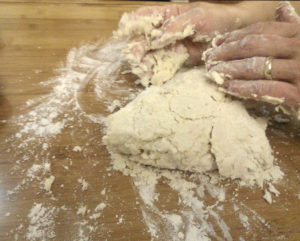 Get the grated frozen butter and toss it with the flour mixture until all the butter is coated. Fold in the chilled milk and sour cream mixture and combine until the batter is quite wet. Turn out onto the floured countertop and with floured hands, knead it about six times. Do not over knead it.Roll the dough with a rolling pin into a 12-inch square. Fold it in half, and then fold again, like folding a napkin. Put it on a plate or similar and put into the freezer for about five minutes. This will rest the dough plus slightly refreeze the butter, yielding a more flaky pastry.
Get the grated frozen butter and toss it with the flour mixture until all the butter is coated. Fold in the chilled milk and sour cream mixture and combine until the batter is quite wet. Turn out onto the floured countertop and with floured hands, knead it about six times. Do not over knead it.Roll the dough with a rolling pin into a 12-inch square. Fold it in half, and then fold again, like folding a napkin. Put it on a plate or similar and put into the freezer for about five minutes. This will rest the dough plus slightly refreeze the butter, yielding a more flaky pastry.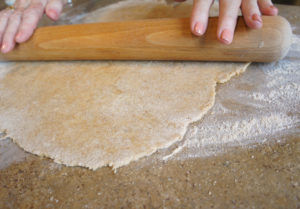 While its in the freezer, dust your countertop with flour again and put a heavy cookie sheet or baking stone into your preheated oven to get it warm. (You might want to use these few minutes to make yourself a cup of tea.)
While its in the freezer, dust your countertop with flour again and put a heavy cookie sheet or baking stone into your preheated oven to get it warm. (You might want to use these few minutes to make yourself a cup of tea.)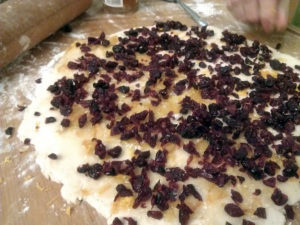 After five minutes, remove the doll and roll your square flat into a 12-inch square. Push the dried cranberries into flattened batter, then spoon the marmalade into a light layer over top. Roll up the dough and turn it over if necessary so the seam is on the bottom. Gently push the roll down until it’s about three inches wide.
After five minutes, remove the doll and roll your square flat into a 12-inch square. Push the dried cranberries into flattened batter, then spoon the marmalade into a light layer over top. Roll up the dough and turn it over if necessary so the seam is on the bottom. Gently push the roll down until it’s about three inches wide.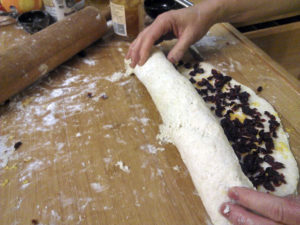 With a sharp knife, cut the roll into a series of triangles. Brush the top with the beaten up and sprinkle lightly with the remaining sugar. Place the triangles on the preheated cookie sheet and bake for 15 minutes or until medium brown. Let the scones rest at least 15 minutes before serving.
With a sharp knife, cut the roll into a series of triangles. Brush the top with the beaten up and sprinkle lightly with the remaining sugar. Place the triangles on the preheated cookie sheet and bake for 15 minutes or until medium brown. Let the scones rest at least 15 minutes before serving.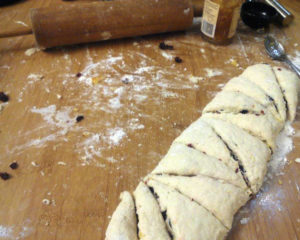
The post Recipe: Simple Scones for the Baking Challenged appeared first on Kathleen Flinn.
October 6, 2020
Recipe: Beef Bourguignon
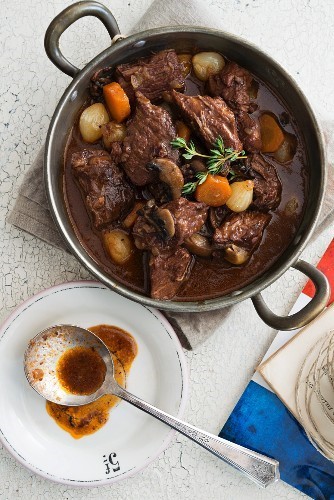
What do you make when the co-author of the book, My Life in France, a memoir of Julia Child’s years living in her beloved second country? There’s only option: Beef Bourguignon.
This was the recipe featured in my first podcast episode, when I chatted with Alex Prud’homme, the great-nephew of the late great Julia Child. We discussed why she chose this particular dish as the star of her very first episode of the TV show that made her famous, “The French Chef.” Listen in.
Julia Child described the dish as “perfectly delicious,” and told the audience that she chose it because it “show you so many useful things about French cooking.” She’s right. You brown meat, saute mushrooms and onions and create a hearty sauce — all in one dish.
(You can watch the original episode via Amazon Prime for three bucks.)
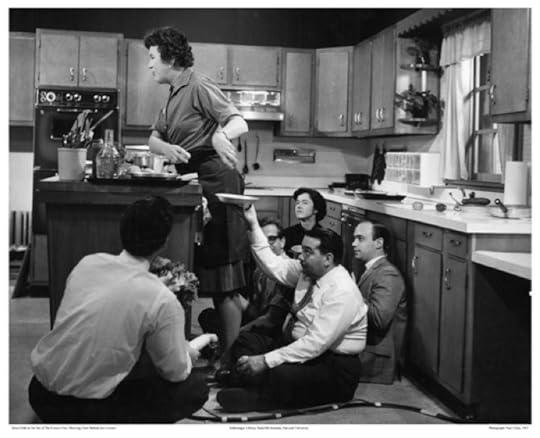 Julia and the crew during the early episodes of The French Chef
Julia and the crew during the early episodes of The French Chef This dish was a touchstone for her, Prud’homme said. “It was the recipe she would come back to again and again.”
Beef Bourguignon gets its name from its humble origins in Burgundy, a picturesque French region located about 60 miles (100 km) southeast of Paris. There the dish is made with its celebrated Charolais beef, which are fed only hay, fodder, and cereal, which produce healthy cows and famously tender meat. The dish began as a simple peasant dish and evolved to a bistro classic that’s even served in white linen restaurants worldwide.
Auguste Escoffier, the chef responsible for codifying French cuisine for the ages, first published the recipe in the early 20th century. His version featured one large piece of beef, a dish that would be more akin to American pot roast. It was Julia Child who introduced the idea of cubed beef, based in part on the dish was served in Paris where they lived while she attended Le Cordon Bleu.
I love this dish. It does have a variety of steps, which takes some time, but it does teach a number of skills. But once it’s in the oven, you can just let it bubble and simmer away. Like many braises, this tastes better the day after you make it, so it’s a great option if you’re entertaining guests. Just reheat and serve. Voila.
You can make this in an Instant Pot or slow cooker and it will be fine. But I recommend going old school and making it in a Dutch oven as the evaporation of the liquid is a key part of the cooking process, as food writer Kat Kinsman found when she tested all three methods.

Beef stew à la Bourguignonne
This is my version of the classic stew based on the version taught at Le Cordon Bleu in Paris. Marinading the beef helps tenderize it before cooking. If you can't find pre-cut stew meat, look for a big chuck roast and cut it up yourself; it's generally cheaper. If you don't have beef stock, you can use chicken instead. I use Better than Bouillon roasted beef if I don't have beef stock on hand. Classic beef bourguignonne includes pearl onions, but those can be hard to find and expensive, so I substitute sweet onions. I like the flavor and saltiness bacon or ham adds to the final dish, and generally freeze the end of a holiday ham for use in this dish, but it's optional. I add balsamic vinegar at the end to add a touch of acid to bring out the beefy flavor. Serve with hot buttered noodles or rice. For entertaining, make a day ahead, reheat and voilà. This also freezes well.You can make this in an Instapot and it will be delicious but will not have the same silky texture as part of the magic is the slow reduction of the wine and stock. See tips at the end of the recipe.
Course Main CourseCuisine FrenchKeyword Beef, French, stew
Servings 8
Author Kathleen Flinn
IngredientsMarinade for beef2 ½ to 3 pounds about 1.5 kg lean beef stew meat cubed1 750 ml bottle of red wine such as Syrah2 medium carrots chopped (about 1 cup)1 medium yellow onion chopped (about 1 cup)4 garlic cloves peeled, smashedParsley stems from one bunch½ teaspoon thyme bay leaf½ cup 125 ml Cognac or brandy optionalStew2 teaspoons coarsely ground black pepper2 teaspoons coarse salt3 tablespoons olive oil8 ounces thick-cut bacon or ham cubed3 tablespoons flour2 tablespoons tomato paste2 cups 500 ml roasted chicken or beef stock3 garlic cloves½ sweet onion sliced8 ounces 250 grams mushrooms, sliced1 medium carrot chopped (about ½ cup)2 cups tomatoes, peeled, seeded, chopped (16 oz can)2 medium white potatoes peeled, cut into ½ inch chunks1 teaspoon dried thyme2 bay leaves2 tablespoons Balsamic vinegar optional3 tablespoons chopped parsley
InstructionsCombine meat with marinade ingredients in a large, non-reactive bowl, stir to mix. Cover with plastic wrap and refrigerate for six hours or overnight. Preheat the oven to 350F/175C. Strain the marinade into a large pot, reserving the liquid. Bring the liquid to a boil while you prepare brown the meat.Remove the meat from the strainer to a plate. Dry with paper towels. Season with salt and pepper. Add oil to a large Dutch oven or 6 quart or larger pot over high heat. Brown the meat in batches and set aside. Lower heat, add the ham or bacon. Cook slowly until slightly browned. Remove half, set aside to add before serving.Add the meat, the vegetables from the marinade and herbs to the pan with the bacon or ham. Sprinkle with flour and stir to coat. Add tomato paste and stir through until hot. Add the boiled wine and stock. Bring to a bubbling simmer, cover, and put into the oven for an hour and 20 minutes.Carefully remove the pan from the oven. Add the garlic, sliced onions, mushrooms, carrots, tomatoes and potatoes and cook until the meat and vegetables are tender, about 45 minutes. Check seasonings, add salt and pepper if needed. Add the reserved bacon or ham, balsamic vinegar and parsley. Serves six to eight.Instapot variationFollow directions to marinade the beef and then boil the separated liquid on the stove while you brown the meat and cook the bacon on the saute setting. After adding the marinade liquid and stock, cook at high pressure for 35 minutes. Let the pressure go down naturally.
Beef stew photo by Veronika Struder. This page contains affiliate links.
The post Recipe: Beef Bourguignon appeared first on Kathleen Flinn.
October 5, 2020
Recipe: Sea Foam Candy
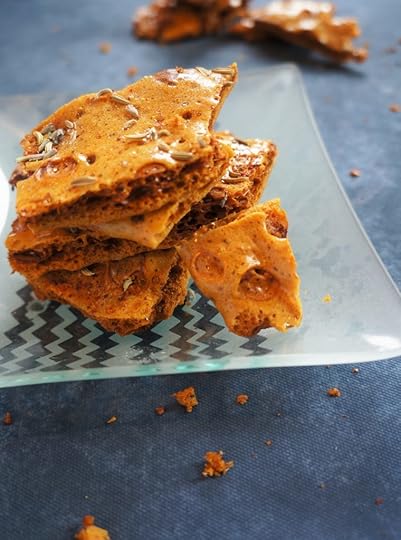
When I was growing up in Michigan, we made trips to the many waterfront towns all over the mitten-shape state. My favorite stop in all these little picturesque hamlets were the local candy stores, virtually all of them offering some variation on the golden, crunchy, sugar-rush concoction known as sea foam candy.
Sea foam candy offers the burnt sugar vibe of an briefly on fire campfire marshmallow but with a lightness and frail crunchiness more reminiscent to meringue. It’s unique texture has led to other names throughout the U.S., from sponge candy to buffalo foam to golden nuggets to my favorite, “fairy candy.” In the UK, it’s known as honeycomb or cinder toffee.
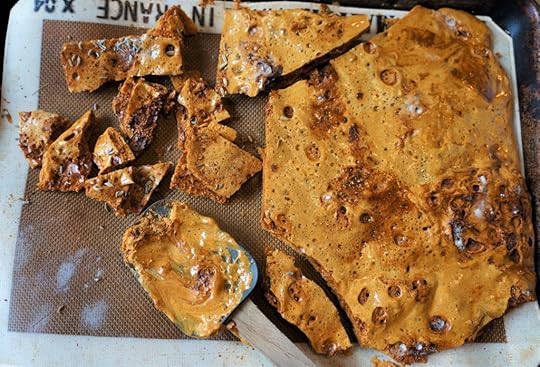
Although it’s a fine candy on its own, candy stores tend to sell it dipped in chocolate and embellished with all kinds of toppings from sea salt to cinnamon to chopped nuts.
A key ingredient in sea foam candy is vinegar, it’s part of what helps yields its distinctive airy, holes and lightweight crunch. This recipe is adapted from one by Aaron Cozadd, Union Woodshop in lovely Clarkston Michigan, courtesy the book Acid Trip: Travels in the World of Vinegar, by Michael Harlan Turkell.
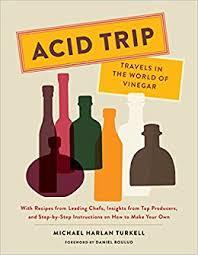
Sugar, vinegar and baking soda: a yummy science experiment
Turkell recommends Aleppo pepper, dried lavender flowers and toasted fennel seeds as elegant toppings, a bit of savory and spice against overtly sweet crunch. I’ve used chopped dried banana chips, toasted sesame seeds and coconut flakes. You’re limited only by your imagination – and if you’ve got a deep enough pan and a candy thermometer.
I first made this for an interview with Turkell on my podcast, Hungry for Words You can listen in to my conversation with him below.
You can listen in to my conversation with him below.
Since then, I’ve kept making it. Once you get the knack, it’s easy to prepare, stores for weeks and makes a great gift. It’s fun to make with kids as a rainy day science-experiment-style activity. My favorite topping is a light spread of sea salt. One Christmas, I topped it with broken candy canes. After all, what goes better with sugar than more sugar? Taking a bite, it took me back to my childhood and a chilly walk in a quiet seaside town decorated with holiday lights, quiet and luminous, except for the crunching.

Sea Foam Candy
Light, airy, crunchy, sweet, that's the brilliance of this simple, yet complex candy. Be sure that you have a nice deep pot with a solid-fitting lid and a candy thermometer. After you add the baking soda, the mixture will double or even triple in size and you don't want it to spill over. You can use any kind of toppings. Author Michael Harlan Turkell, who published this recipe in his awesome book, AcidTrip: Travels in the World of Vinegar, recommends Aleppo pepper, dried lavender flowers and toasted fennel seeds. I’ve used flaky sea salt, broken up dried banana chips, toasted sesame seeds and coconut. You could also temper a bit of chocolate and dip the cooled pieces into it, then let them cool. Stored in an airtight container, the candy will keep for about a month. Makes one pound for about $2.
Course DessertCuisine AmericanKeyword candy, gifts, holidays, Midwest, toffee, treats
Cost $2
EquipmentLarge pot (6 quarts or larger) with lidCandy thermometerWhiskHeatproof spatulaBaking sheetSilicon baking mat or parchment
Ingredients2 1/2 cups sugar (450g)3 tablespoons honey or corn syrup1/4 cup cider vinegar (60ml)1 cup water (240g)1 tablespoon + 1 teaspoon baking sodaOptional toppings3/4 cup tempered milk, dark or white chocolate2 tablespoons lavender flowers, aleppo chili or fennel seeds (optional)
InstructionsBefore you begin, line a baking sheet with a silicon mat or parchment. Get a set of oven mitts, a whisk and a heatproof spatula and have them ready. Combine the sugar, corn syrup, cider vinegar and water in a deep pot. (In other words, everything but the baking soda.) Place the pot over high heat and cover. The lid is essential as its keep the sugar from crystalizing on the side of the pot. Bring the mixture to a boil. As the water evaporates, you’ll hear the boiling get louder, like rain moving in close from a distance.Lift the lid and affix your candy thermometer to the side of the pot and then recover with a lid so you can watch the temperature. Continue to boil until the temperature reaches 290F/145C. Carefully whisk in the baking soda and let the mixture bubble up to allow air bubbles to form. Using oven mitts, grab the pan and immediately pour it out on the lined baking sheet. Sprinkle your toppings over the top quickly and let it cool for 20 minutes or more. Once cooled, break the candy into pieces.
All photos by Kathleen Flinn
The post Recipe: Sea Foam Candy appeared first on Kathleen Flinn.
October 2, 2020
Recipe: Coq au vin
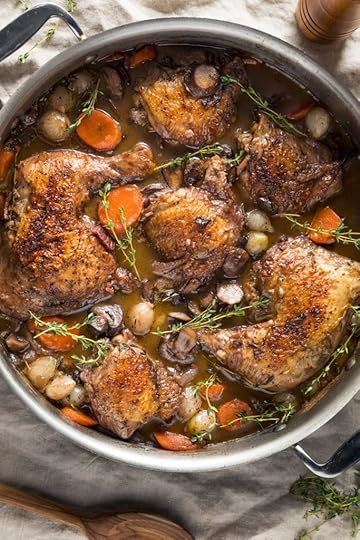
Go ahead. Impress people. Tell them you’re making coq au vin. It’s just chicken braised in wine, thus making it fabulous.
In its original French inception, the coq referred to a rooster, typically mean old birds who wore out their welcome in the hen house. The tough nature of the meat required a long simmer time to soften. Wine was used to help soften up the meat thanks to its sugar content.
At Le Cordon Bleu in Paris, we made the classic version that includes pearl onions and lardons, diced pieces of salted pork. In the U.S., I use a quality bacon over lardons as it’s easier to find and lends an earthy bit of flavor.
Pearl onions do impart a certain sweetness, but they tend to be wickedly expensive and take a woefully long time to peel. Use them if you prefer. You can find them frozen, but the resulting texture tends to be a bit mushy. I’ve made this dish with both pearl onions and classic yellow and it’s good both ways.
Given that the odds of finding a rooster at your local supermarket are essentially none, I recommend employing chicken thighs and legs – or better yet, the full hind quarter piece with leg and thigh attached. Avoid breast meat. The long braise will leave it as dry as a Christian county in the south on a Sunday.
Speaking of which, even though this dish calls for wine, it remains an economical dish. You don’t need an expensive bottle of wine, just one that you would drink. I’ve made this with inexpensive table wine and a spendy French red and frankly, it’s a struggle to tell the difference. This is great for entertaining or to prepare weekday meals in advance on the weekday, as it taste better reheated.
Not a red wine fan? Use white wine or an inexpensive sparkling wine in place of red. When Mike and I visited the Chablis region once, we ordered coq au vin and lo and behold, it came swimming in the region’s famed white. The end flavor tends to be a bit sweeter and lighter, yet still hearty and savory.
I usually buy two bottles of wine for this dish – one to cook the chicken in, and one to drink with it when it’s done. This dish also calls for brandy or Cognac, and while optional, definitely adds something to the dish, but you don’t buy a big bottle if you don’t have it on hand.
Paired with noodles or mashed potatoes, this serves six to eight.
– Updated October 3, 2020
Other recipes of interest:
How to make basic chicken stock (video)
How to cut up a whole chicken (video)

Coq Au Vin (Chicken Braised in Red Wine)
Coq au Vin or "Chicken with Wine" is a classic French braised dish that sounds impressive but is surprisingly inexpensive and uncomplicated. If you don't want bones in the finished dish, use 3 pounds of boneless thighs. Use a higher-heat oil for the chicken, such as avocado or canola; olive oil will smoke too much.
Course Main CourseCuisine FrenchKeyword braise, budget friendly, chicken, chicken legs, chickent thighs, comfort food, French cuisine, whole chicken
Prep Time 45 minutesCook Time 2 hours
Servings 6 servings
EquipmentDutch oven or heavy pot with lid
IngredientsFor the braise5 lbs chicken, preferably thighs, legs or quarter pieces3 tablespoons vegetable oil8 ounces (250g) pancetta or bacon, diced2 medium yellow onions chopped (about 2 ½ cups)4 ribs celery chopped (about 1 ½ cups)2 medium carrots about 1 ½ cups3 tablespoons butter2 tablespoons all-purpose flour2 tablespoons brandy or Cognac3 cups (700 ml) chicken stock1 bottle dry red wine (about 2 cups)4 cloves garlic chopped10 sprigs thyme tied togetheror 1 tablespoon of dried thyme2 bay leavesCooked separately from braise½ sweet onion sliced8 ounces (250g) brown mushrooms sliced3 tablespoons parsley choppedServe withMashed potatoes or wide noodles
InstructionsPreheat oven to 350°F /180°C. Pat dry wtih paper towels. Cut off extra fan and excess skin. Season the chicken pieces with salt and pepper. In a heavy Dutch oven, brown in batches in hot oil over high heat, set aside. It’s important to get the chicken nice and browned, as shown. Don’t rush this step; properly browned chicken is a key to the final outcome.
 Turn the heat to medium-low and add the Pancetta or bacon and cook slowly until slightly browned. Add the onions, celery and carrot and stir until tender. Add the brandy, reduce slightly. Sprinkle with flour and stir until coated.
Turn the heat to medium-low and add the Pancetta or bacon and cook slowly until slightly browned. Add the onions, celery and carrot and stir until tender. Add the brandy, reduce slightly. Sprinkle with flour and stir until coated.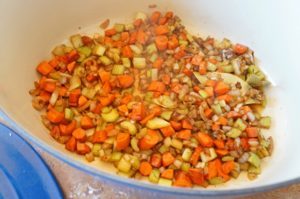 Return the chicken to the pan. Add the chicken stock, garlic and herbs. Then, add enough wine so the liquid just covers chicken pieces; this could be two cups or four. Bring the liquid to a boil, skimming off any foam or fat. Cover tightly and place in oven for about two hours or until meat is very tender.
Return the chicken to the pan. Add the chicken stock, garlic and herbs. Then, add enough wine so the liquid just covers chicken pieces; this could be two cups or four. Bring the liquid to a boil, skimming off any foam or fat. Cover tightly and place in oven for about two hours or until meat is very tender.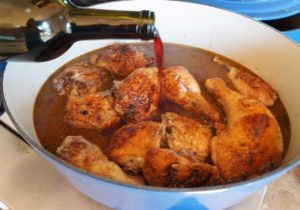 Meanwhile, cook the sweet onions and mushrooms in a medium skillet in 2 tablespoons of butter. Before serving, add the mushrooms, onions and chopped parsley. Check seasonings, adding salt and pepper until it taste right to you. Serve with noodles or mashed potatoes.
Meanwhile, cook the sweet onions and mushrooms in a medium skillet in 2 tablespoons of butter. Before serving, add the mushrooms, onions and chopped parsley. Check seasonings, adding salt and pepper until it taste right to you. Serve with noodles or mashed potatoes.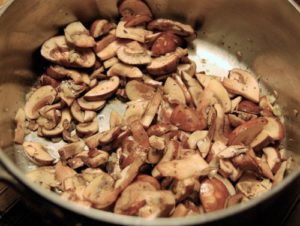
Process photos by Kathleen Flinn. Finished dish photo by Brent Hofacker.
The post Recipe: Coq au vin appeared first on Kathleen Flinn.
Recipe: Perfect Mashed Potatoes
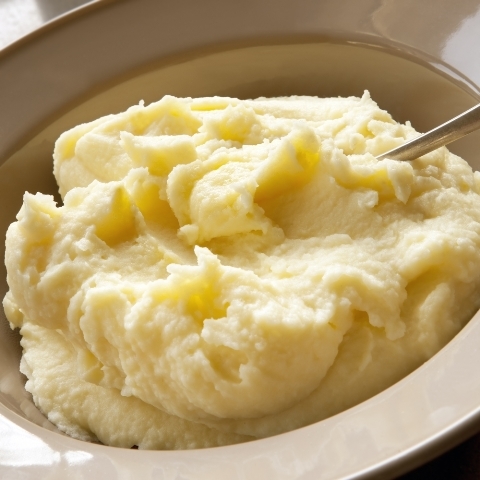
Such a simple thing — throw some potatoes into a pot, then mash them up, but there’s more to creamy mashed potatoes than that. I tend to make mashed potatoes a day ahead of a big family dinner and gently reheat in the oven; microwaving them tends to change the texture. Alternately, make them earlier in the morning and keep them warm by covering a pan with plastic wrap and nestling into a simmering pan of water. This simulates being held in a steam table. Here are a few key tips, many gleaned from my studies at Le Cordon Bleu in Paris.
Key tip #1:
Always start cooking potatoes in cold water. Don’t plop them into boiling water. Cook them at a modest simmer for about 20 minutes and they will have a smoother end texture and cook more evenly.
Key tip #2:
Slice peeled potatoes or if you’re more adept with a knife, chop into even chunks for even cooking
Key tip #3:
Two camps of thought exists on the type of potato to use. Some swear by Yukon Gold, others say go with classic Russetts. Either are fine.
Key tip #4:
Never try to mash up cold potatoes. It has to do with some chemical-y thing with the starch. If your potatoes go cold, heat them up again (in warm water, a microwave) and then try to mash them.
Key tip #5:
Use room temperature or warm milk when mashing. Let butter soften to room temperature, too. It will be easier to mash and won’t cool down the potatoes. (See Tip #4)
Key tip #6:
Don’t even think about putting potatoes into a food processor. The result will be a gluey mess. I prefer using a food mill to mash them, other people swear by a ricer. My mom prefers a 1969 hand-held electric beater. My friend Chef John in the video below prefers a specific kind of masher. Honestly, you can always just use a fork too. The key, though, is no food processor.
Key tip #7
Save the drained potato water. It’s gives body to gravy and also makes a terrific base for soups, so try not to throw it out.
Perfect Mashed Potatoes
2 1/2 pounds of potatoes, Yukon Gold or Russet, peeled
8 oz of butter
1/2 cup milk, heated
Plenty of salt and pepper
Pinch or two of ground nutmeg (optional)
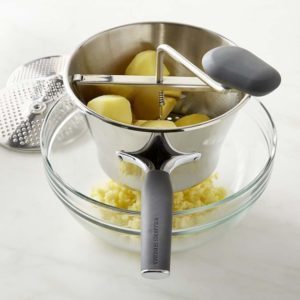 Peel the potatoes and then slice into even pieces. Add them to a pan of cold water and then bring to a gentle boil. Cook until the potatoes are soft enough to pierce with a paring knife, about 10 minutes. Drain. At this point, situated a food mill over a large bowl or pot. Add a few potatoes at a time and press through the food mill. Alternately you can use a ricer or, should you want to go old-school, use a hand-held masher. Just be sure that while the potatoes are still warm, add the heated milk the butter, salt and pepper. If you wait until they’ve become cold, the flavors will not meld properly. Taste. Add salt and pepper until it taste good to you.
Peel the potatoes and then slice into even pieces. Add them to a pan of cold water and then bring to a gentle boil. Cook until the potatoes are soft enough to pierce with a paring knife, about 10 minutes. Drain. At this point, situated a food mill over a large bowl or pot. Add a few potatoes at a time and press through the food mill. Alternately you can use a ricer or, should you want to go old-school, use a hand-held masher. Just be sure that while the potatoes are still warm, add the heated milk the butter, salt and pepper. If you wait until they’ve become cold, the flavors will not meld properly. Taste. Add salt and pepper until it taste good to you.
To hold the potatoes to serve later, make a bain-marie. This is a fancy name for keeping the potatoes warm by placing into a hot water bath. To do this, place the potatoes into a metal bowl or pot if they are not already in one. Add a sheet of plastic wrap over the top and close tightly. Then, find a saute pan or skillet large enough to hold the bowl or pot. Add a bit of water, bring to a boil and then turn down to simmer. Add the pot or bowl to the simmering water. Check them every so often to adjust the heat to keep the potatoes warm. They can be kept hot for hours this way.
Variations:
Parmesan mash: I’m a big fan of grating in about a tablespoon of fresh Parmigiano-Reggiano into potatoes and grating it into them.
Mixed root mash: Lately, I’ve been a big fan of adding a turnip and/or a rutabaga into the whole mix, thanks to Diane Morgan’s book Roots. It adds an extra layer of complexity, an especially nice touch when pairing the mash with meats.
Garlic mashed potatoes: add two cloves of garlic toward the end of the boiling process. Then mash them into with the potatoes.
Olive oil mash: Substitute olive oil for all or a portion of the butter. Adds a different flavor and cuts down on saturated fats
Updated October 2020. This post may include affiliate links
The post Recipe: Perfect Mashed Potatoes appeared first on Kathleen Flinn.
October 1, 2020
Recipe: Popovers
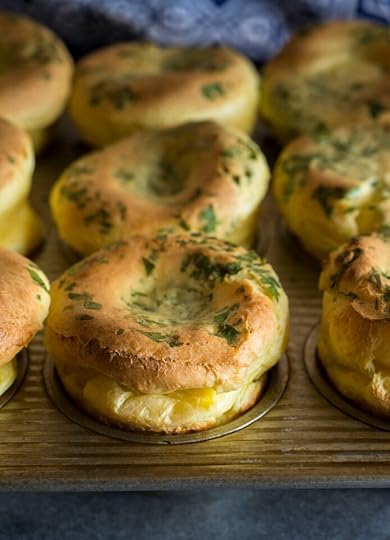
I’ve long been fascinated by popovers and for this, I blame Dorothy Parker.
For those unfamiliar, Dorothy was a fabulously wry writer who was among the founding members of “the vicious circle” of writers who made up The Algonquin Roundtable in New York. Starting in 1919, the group of thirty newspaper and magazine writers met almost daily for lunch over the course of about ten years to share gossip, jokes and cultural observations. Through their writings, the conversations around their lunch table in the dining room became national fodder. Dorothy, in particular, became known for her remarkable wit. The group led to the creation of a magazine that you may have heard of, The New Yorker. Many went on to celebrated careers. Parker sold three books of acclaimed poetry, won an O. Henry Award for her short story, “Big Blonde,” and was nominated for an Oscar for co-writing 1939’s “A Star is Born.” While she lived a public life of acclaim, her internal life was often tortured and she slipped into alcoholism late in life. Parker has been one of my favorite writers since I first read her work. Her humor, use of sharp descriptions and subtlety in commenting on important issues still inspire me today.
As a food writer, I did some research on what the group ate during their ten-year lunch. It was the usual fare of the 1920s, continental fare influenced by French. Shrimp cocktails, cold fish cakes with lemon cream sauce, various cuts of beef in red wine sauce, that sort of thing. The hotel manager, happy that the group made its home there, offered them a regular table and waiter along with two enduring food items served gratis: celery and popovers. Popovers? I always wondered why.
The Algonquin has a special place in my heart. When my first book, The Sharper Your Knife, was on its way to auction, I traveled  to New York to meet with the ten publishers (yes, ten) who wanted to buy it. As a Dorothy Parker devotee, my husband thought that staying at the city’s most celebrated literary hotel would offer good karma and he found a good deal for a room online. My agent and I went around to meet with seven publishers one day and three the next. After the whirlwind, I packed up and met my long-time friend J.R. in the hotel’s dark wood-paneled bar for a glass of champagne. I tried to be cool, but I was mystified at how this improbable moment could possibly be happening. It felt as if I had somehow stepped into another person’s life. We were talking about popovers and the auction expected to take place the following week when my phone rang.
to New York to meet with the ten publishers (yes, ten) who wanted to buy it. As a Dorothy Parker devotee, my husband thought that staying at the city’s most celebrated literary hotel would offer good karma and he found a good deal for a room online. My agent and I went around to meet with seven publishers one day and three the next. After the whirlwind, I packed up and met my long-time friend J.R. in the hotel’s dark wood-paneled bar for a glass of champagne. I tried to be cool, but I was mystified at how this improbable moment could possibly be happening. It felt as if I had somehow stepped into another person’s life. We were talking about popovers and the auction expected to take place the following week when my phone rang.
“So a publisher wants to pre-empt the auction,” my agent explained. A pre-empt happens when a publisher offers an advance as high or higher than a manuscript is expected to raise at auction. I asked him what I should do. “I think you should take it!” he said enthusiastically. So I did, and the auction was over.
I hung up. I explained that I’d just sold my book to the waiter. With great flourish, he and the manager brought over two glasses of champagne on the house… and a basket of warm popovers. “We overheard you talking about them, and we have them on the menu at the moment,” the manager explained, a bit awkwardly, admitting to eavesdropping. “I hope it’s OK.” I asked him, why did they serve popovers to the round table members? “Because they’re delicious?”
We toasted to the book sale, and ate popovers. They were awfully good.
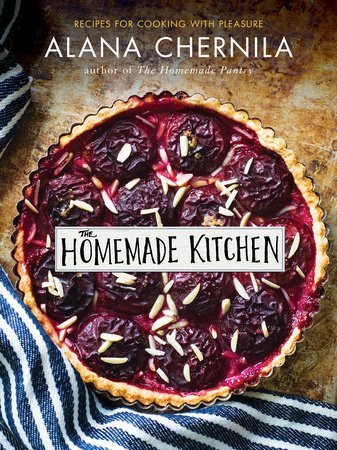
Oddly, however, I’ve never made them — until a couple weeks ago. I’ve been collecting audio interviews for a podcast that I’m planning to launch soon. One of my first interviewees was Alana Chernila of the lovely blog, Eating from the Ground Up. She arrived in the midst of a busy book tour on a crisp autumn morning to hang out in my kitchen. I wanted to make something from her new book, The Homemade Kitchen, so imagine my delight when I saw she had a recipe for popovers.
It turns out that popovers are remarkably easy. You put the ingredients into a blender, puree it and pour into an oiled muffin or popover tin. The hardest part is not opening the oven while the bake. I had some fresh dill on hand, so that’s what I used along with chevre. Alana and I sat in my kitchen, drinking tea and talking popovers and book tours. I’ve added them to my Thanksgiving menus for approximately forever.
It reminded me that sometimes we wait too long to try things, only to find they were so easy. All I needed was a few ingredients and some patience. Oh, and a blender.

Print
Recipe: Popovers from 'A Homemade Kitchen'
I have one back-pocket recipe that can save any breakfast, lunch, or dinner. Special birthday breakfast on a school morning when we have to get out at 7:00 a.m.? Popovers. A soup pulled from the freezer that’s not quite as delicious as I remember it? Serve with popovers. Friends coming over with picky kids? Anything + popovers. Of course, I wish all my meals were flawless and delicious, and all my experiments came out cookbook-worthy. But for the meals that do n’t quite make it, popovers save the day. This is also a great recipe for kids, because once it’s in your blood, you can rely on it for life. The blender, along with the hot oven, creates a lofty popover with a hollow center. Although you can buy a special fancy popover pan, this recipe works just fine in a regular muffin tin. If you prefer a more custardy popover, mix the ingredients by hand and bake in a 375°F oven for 30 to 35 minutes.
Course BakingCuisine American
Prep Time 10 minutesCook Time 28 minutesTotal Time 38 minutes
Servings 12 popovers
Author Alana Chernila
Ingredients3 large eggs1½ cups 360 ml whole milk or buttermilk (for homemade, see page 34)1½ cups 180 g all-purpose flour½ teaspoon kosher salt4 tablespoons ½ stick/56 g unsalted butter, melted and slightly cooledSafflower oil or melted butter for greasing the panOptional: ¼ cup fresh herbs; 4 ounces 115 g chèvre
InstructionsPreheat the oven to 425°F. Combine the eggs, milk, flour, salt, and butter in a blender. Blend until you have a smooth batter, 15 to 20 seconds. Let the batter rest for about 10 minutes.Generously grease a 12-cup muffin or popover tin with oil. Divide the batter evenly among the cups, filling them most of the way. Add a pinch of fresh herbs and a dollop of chèvre, if using, to the center of each muffin cup. Bake until puffed and golden, WITH OUT OPENING THE OVEN, 25 to 28 minutes. Serve immediately.
The post Recipe: Popovers appeared first on Kathleen Flinn.






